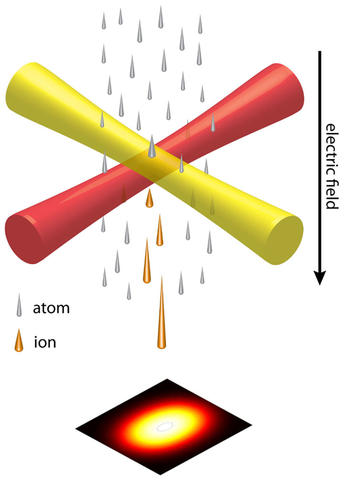
Researchers from the NIST Center for Nanoscale Science and Technology and zeroK Nanotech Corporation have demonstrated a new ion source* that may enable focused ion beams with high brightness and resolution for nanoscale fabrication and measurement applications in fields ranging from semiconductor manufacturing to biotechnology. Working under a cooperative research and development agreement (CRADA), the researchers have constructed the first prototype of a low-temperature ion source (LoTIS), which utilizes the extremely cold temperatures attainable with laser cooling to produce a highly collimated, bright ion beam.
Unlike the magneto-optical trap ion source (MOTIS), a previous NIST technology that uses lasers and magnetic fields to trap and cool in three dimensions a group of atoms before ionizing them and extracting a beam, LoTIS begins by generating a cold, but slowly moving atomic beam using a two-dimensional magneto-optical trap. The beam of atoms is then compressed and further cooled to below 30 µK using counter-propagating polarized laser beams that slow the atoms in a region where the laser beams intersect. The atom beam then enters an ionizing laser beam. The result is a source with much higher brightness than the MOTIS. High brightness translates into an ability to focus an ion beam to very small dimensions because it allows more current to be concentrated into a smaller spot.
Based on their measurements and modeling of the source, the researchers predict cesium beams created with LoTIS will have focal spot sizes of less than a nanometer with currents in the picoampere range. Such performance would go well beyond the capabilities of the gallium liquid metal ion sources commonly used in industry, and promises to answer key needs for the next generation of nanoscale manufacturing. Major applications for the LoTIS include semiconductor circuit editing and nanoscale secondary ion mass spectrometry (SIMS).
The LoTIS technology, initially developed at NIST by the research team, has been patented and is now under license to zeroK Nanotech.
*Cold atomic beam ion source for focused ion beam applications, B. Knuffman, A. V. Steele, and J. J. McClelland, Journal of Applied Physics 114, 044303 (2013).
NIST Publication Database Journal Web Site

